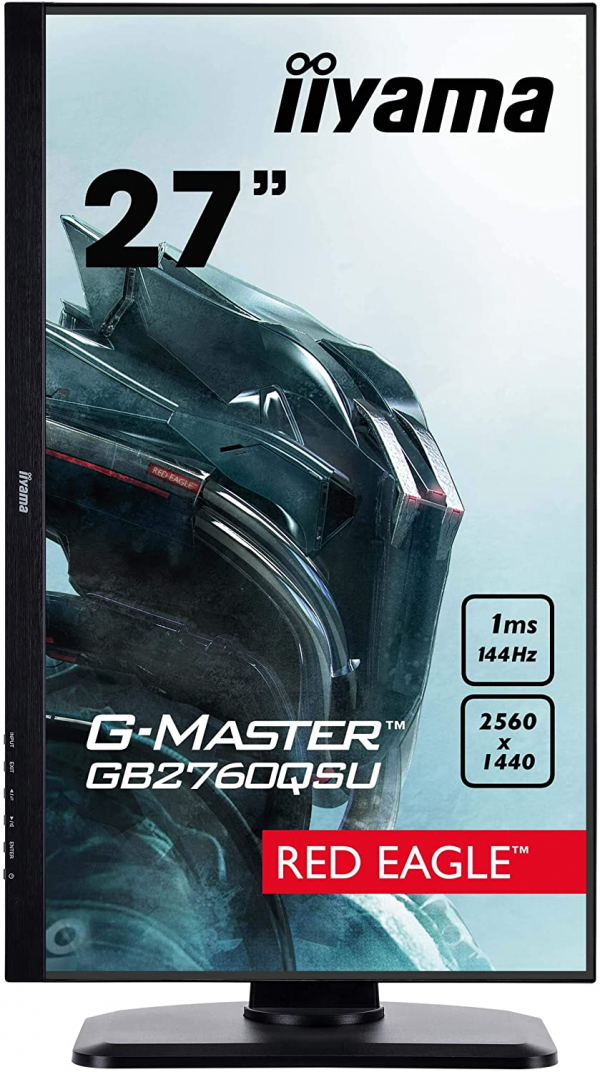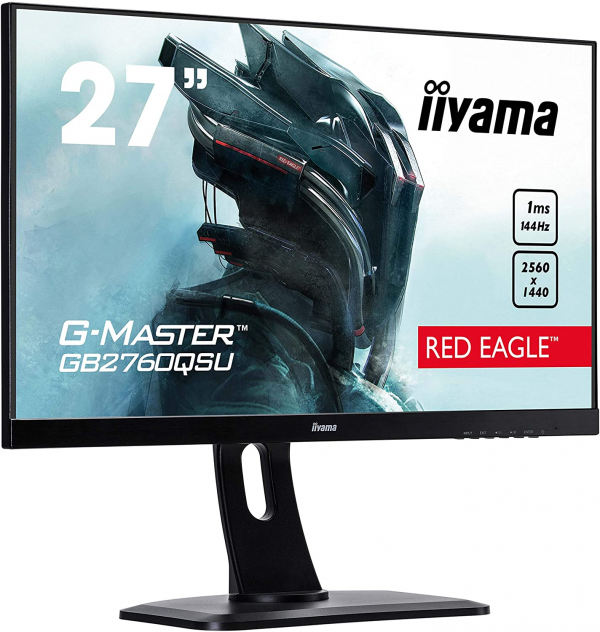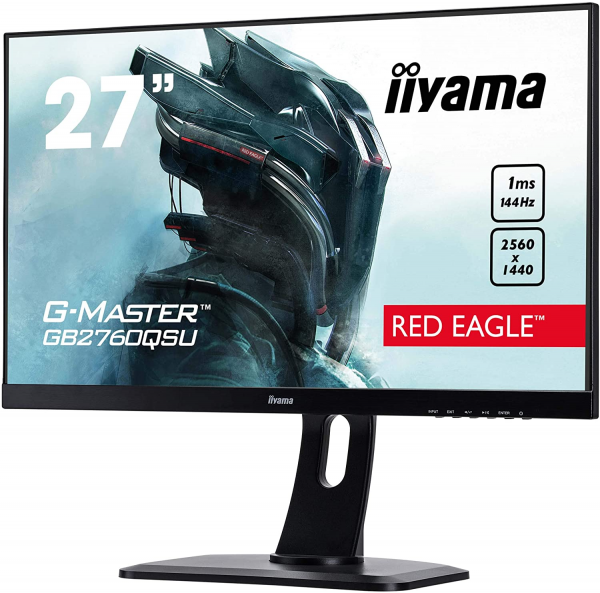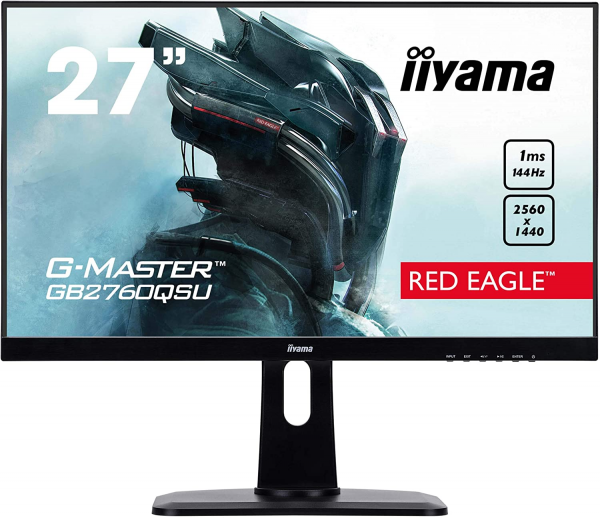Iiyama
Iiyama G-Master GB2760QSU-B, a 27-inch Quad HD FreeSync 144 Hz monitor
Aprox. 338€
See specificationsThe Iiyama G-Master GB2760QSU-B1 monitor is simply a more advanced version of the G-Master GB2788HS. The definition goes from Full HD (1,920 x 1,080 px) to Quad HD (2,560 x 1,440 px) for more versatility and it finally has a USB 3.0 hub.
Positive points
Definition Quad HD versatile (office and game).
Very good reactivity (4.5 ms).
Refresh rate at 144 Hz!
FreeSync compatible.
Ergonomics.
Two USB 3.0 ports on the side.
Bad points
Contrast ratio.
Viewing angles.
Our review
Presentation
The Iiyama G-Master GB2760QSU-B1 monitor has a 27-inch TN panel with a resolution of 2,560 x 1,440 px, compatible with AMD's FreeSync variable refresh technology. At less than 500 €, this model displays an excellent quality / price ratio, since only the Asus MG278Q, sold a little more expensive, offers the same characteristics (Quad HD, 144 Hz, FreeSync). The Iiyama screen is fully adjustable (height, tilt, rotation) and even has a pivot mode to switch it to portrait orientation. Connectivity is also quite good and it even has speakers.

Ergonomics
The Iiyama-GMaster-GB2760QSU-B1 takes the classics of the brand in terms of ergonomics. The slab is thus mat with an anti-reflective treatment. The design is versatile, with a matte black plastic that does not look very luxurious, but which at least has the merit of aging well.
The rear is of the same ilk. The only notable difference compared to other monitors of the brand is the appearance of the mention G-Master on the arm. We still note the presence of a basic cable management system.
The Iiyama GB2760 takes the settings of its big brothers, with a foot adjustable in height by 13 cm, an inclination of -5 ° to + 22 °, a rotation of more or less 45 ° on the foot and a portrait mode. The transition from landscape to portrait mode is perfectly smooth and without any plastic noise, which is a guarantee of quality of assembly and mastered finish.
In terms of connectivity, this Iiyama monitor is also generous: an HDMI input, a DVI Dual Link input and a DisplayPort 1.2 input essential to benefit from FreeSync technology. The screen also offers an audio input to power the two integrated 2-watt speakers and also a headphone output. Finally, it has a hub with two USB 3.0 ports accessible on the left side.
The OSD system - OnScreen Display - is evolving. It is more fluid than on the old Iiyama monitors and the menus are a little clearer. We are very far from what Asus offers with its joystick and BenQ.
As with the Prolite B2483HSU-B1 and the XB2783HSU, Iiyama tried to reduce the edges of the screen. As you can see, the official photo of the product is quite misleading, since even if the screen edges are thinner (6 mm on the sides, 5 mm above), they remain clearly visible.
By default, this monitor consumes 22 watts at 150 cd / m² with the brightness set to 10, ie a relative consumption of 109 W / m², slightly higher than the average consumption (100 W / m²) on the monitors tested in our laboratory. . 8 hours a day, 5 days a week, it will cost you around 7 € per year. At maximum brightness (421 cd / m²), the monitor consumes 42 watts and drops to 20 watts in minimum brightness (118 cd / m²).

Colors and contrast
Default: gray color temperature 7480 K
Default: gamma curve at 2.2
Default: Delta E at 3.6
Out of the box, the Iiyama GB2760QSU-B1 is doing pretty well in terms of colorimetry. The gamma curve is perfect with an average value of 2.2. The average temperature (7,480 K), for its part, is a bit far from the 6,500 K reference and results in a slightly cold rendering. Finally, Delta E is slightly higher than 3 (3.6), the threshold above which the human eye begins to perceive differences between the shades of color. The colors cannot therefore be considered as faithful.
Manual adjustment: gray color temperature 7050 K
Manual adjustment: gamma curve at 2.2
Manual adjustment: delta E to 3.4
By lowering the brightness to 10, the screen reaches 150 cd / m². The gamma curve does not move, as the temperature drops to 7,050 K, a value closer to the 6,500 K reference. The colors are slightly more faithful (delta E of 3.4), but the Delta E still remains greater than 3. Above all, the green displays a delta E of 8, quite far from the expected green.
Sensor calibration: gray color temperature 6820 K
Probe calibration: gamma curve at 2.2
Probe calibration: delta E to 3.0
Passing through the calibration probe makes it possible to stabilize the temperature curve and get a little closer to the target value (6,500 K). The average temperature is measured at 6,820 K. The colors are a little more faithful (average delta E at 3.0). Our calibration profile is available at this link.
The contrast of 925: 1 is very good for a TN panel, but it cannot compete with that of the best VA monitors which exceed 3000: 1, in particular the Eizo Foris FG2421.
We noted an average difference in white homogeneity of only 5% over the entire TN panel. Unfortunately, this good homogeneity is sealed by the reduced angles of the TN panel, in particular the vertical angles which reveal a gradient when a uniform sun is displayed. However, we did not find any light leaks or clouding.

Reactivity
The screen does not use Pulse Width Modulation (PWM) to manage the backlight system, this brightness adjustment technology which varies the intensity of the LEDs permanently and causes eye strain and headaches for people who are too sensitive to them.
On this monitor, the FreeSync operates between 48 and 144 Hz (50 and 144 Hz in HDMI) with exemplary fluidity. When the graphics card delivers less than 48 images per second, it is however possible to encounter micro-decelerations, a phenomenon called stutter. FreeSync allows the screen to synchronize the refresh rate with the number of images sent by the graphics card, hence the absence of image tearing effects - the famous tearing visible on screens that lose their synchronization with the graphics card.
By default, the overdrive at 0 offers the best setting. It limits the ghosting effect with a very slight reverse ghosting effect. The faster settings provide a rather annoying reverse ghosting. Responsiveness, on the other hand, is very good, even if it cannot compete with the latest 240 Hz monitors like the Acer Predator XB252Q and the BenQ Zowie XL2450 which drop to 3.5 ms.
The display delay is only 10.8 ms. The delay between the program and the display of the image on the screen is tiny and will not bother players, even the most experienced.

Conclusion
The Iiyama G-Master GB2760QSU-B1 is an excellent monitor for gaming which also benefits from a certain versatility. Responsive, it supports a frequency of 144 Hz and FreeSync which allow you to enjoy exemplary fluidity in games. In addition, the excellent ergonomics, the definition Quad HD and the USB hub make it an excellent daily companion. It remains to adapt to the shortcomings of TN technology (limited viewing angles and contrast).

Specifications

